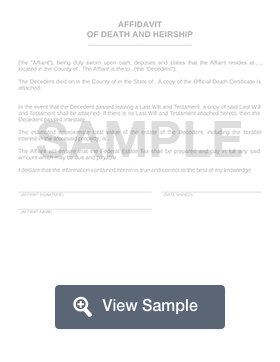Affidavit of Heirship Form
An Affidavit of Heirship is a written solemn oath that verifies the named individual is a legal heir of someone who died. Generally, the document is used if a person dies without a will and the probate court is trying to determine how the estate should be distributed. It may also be used by an heir who wishes to take possession of the decedent's estate so that they may transfer the title or ownership of something that belonged to the decedent.
What is an Affidavit of Heirship?
An Affidavit of Heirship is a legal document that declares that someone is the heir of a deceased person. Typically, an heir is a blood relative of the deceased, such as a spouse, child, or other immediate family members. An affidavit such as this may be used to declare rightful ownership over property or an estate.
Other Names For an Affidavit of Heirship
- Heirship Affidavit
When To Use an Affidavit of Heirship
Whenever someone dies without a will and leaves real or personal property behind, their heirs may need to open a case in probate court in order to have title to that property pass to them. Quite possibly the most widely used and least expensive way to do this is with an Affidavit of Heirship.
An Affidavit of Heirship can be used if you want to transfer title from a deceased loved one's name into your own name in the following situation:
- The decedent died without a will (intestate);
- You want to identify yourself as the decedent's lawful heir;
- You want to assume possession of the decedent's estate without going through probate; and/or
- All of the decedent's heirs have agreed on how the decedent's estate should be disbursed.
With an Affidavits of Heirship, you can transfer title to real property a lot cheaper and faster than through the probate process. This is because you don't have to go to court.
Affidavits of Heirship are commonly used to transfer real estate that is titled in the name of a spouse or family member who has died intestate, as well as, when there is a will and all of the decedent's heirs agree on how the decedent's estate should be disbursed.
It is important to note, however, an Affidavit of Heirship will not work in every situation. Each state differs on how an Affidavit of Heirship may be used.
Components of an Affidavit of Heirship
- The Affiant
The first component of an Affidavit of Heirship template is information on the Affiant. This is the person who is making the declaration and they must enter their name, address, and any other applicable contact information.
- Declaration of Relation
The second component is a declaration of knowing the deceased. Written in the first person, it declares the Affiant knew the decedent, including the name, time, cause, and place of death, as well as the relationship to the Affiant.
- The Departed
The third component of the Affidavit of Heirship template is the marital status and marital history of the departed at the time of death. This is relevant since not only current but past spouses may also have claims to the estate in certain states and under certain conditions. The next component of any Affidavit of Heirship will be a family history, including a comprehensive list of known surviving heirs.
- Signatures, Etc.
Finally, the document concludes with a declaration by the Affiant written in the first person, that the information above is true and comprises the whole of the Affiant’s knowledge on the deceased. It ends with a space for a signature, a date, and another mark for the notary public officiating the proceedings.
Legal Considerations for an Affidavit of Heirship
- Required Signatures
To be effective, an Affidavit of Heirship has to be taken before a notary republic and signed by 2 disinterested third parties who have personal knowledge of the decedent and his or her family. Most importantly, the witnesses must swear that, based on their personal knowledge of the decedent and his or her family, the persons listed as the decedent's heirs in the document are in fact his or her true heirs. A notary signature and notary seal are required.
- Filing an Affidavit of Heirship
An Affidavit of Heirship must be filed with the county records of the county where the property is situated. Usually, after having been on record for a number of years, an Affidavit of Heirship that was filed properly will be deemed valid. Until then, some title companies will have a problem with you trying to sell or transfer title to the property to any third party.

